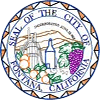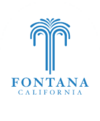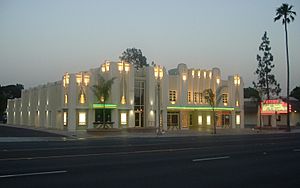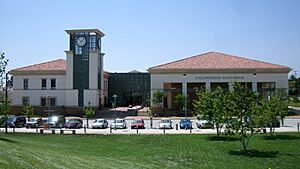Fontana, California facts for kids
Quick facts for kids
Fontana, California
|
|||||
|---|---|---|---|---|---|
|
Counterclockwise: Cucamonga Peak in the San Gabriel Mountains; Fontana Center Stage; aerial view of Fontana; Lewis Library
|
|||||
|
|||||
| Motto(s):
"City of Action"
|
|||||
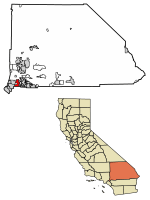
Location of Fontana in San Bernardino County, California
|
|||||
| Country | United States | ||||
| State | California | ||||
| County | San Bernardino | ||||
| Founded | 1913 | ||||
| Incorporated | June 25, 1952 | ||||
| Named for | Italian for fountain or water source; in reference to the Santa Ana River | ||||
| Government | |||||
| • Type | Council-Manager | ||||
| Area | |||||
| • Total | 52.04 sq mi (135.72 km2) | ||||
| • Land | 52.04 sq mi (135.72 km2) | ||||
| • Water | 0.00 sq mi (0.00 km2) 3% | ||||
| Elevation | 1,237 ft (377 m) | ||||
| Population
(2020)
|
|||||
| • Total | 212,704 | ||||
| • Rank | 2nd in San Bernardino County 20th in California 109th in the United States |
||||
| • Density | 4,838.47/sq mi (1,868.16/km2) | ||||
| Time zone | UTC−8 (PST) | ||||
| • Summer (DST) | UTC−7 (PDT) | ||||
| ZIP codes |
92331, 92334-92337
|
||||
| Area codes | 909, 840 | ||||
| FIPS code | 06-24680 | ||||
| GNIS feature IDs | 1652711, 2410517 | ||||
Fontana is a city in San Bernardino County, California, United States. Founded by Azariel Blanchard Miller in 1913, it remained essentially rural until World War II, when entrepreneur Henry J. Kaiser built a large steel mill in the area. It is now a regional hub of the trucking industry, with the east–west Interstate 10 and State Route 210 crossing the city and Interstate 15 passing diagonally through its northwestern quadrant. The city is about 46 miles (74 km) east of Los Angeles.
The United States Census Bureau reported that Fontana's 2020 population was 208,393, making it the second-most-populous city in San Bernardino County and the 20th largest in the state.
Contents
History
Fontana was founded in 1913 by Azariel Blanchard Miller. Within a few years it became an agricultural town of citrus orchards, vineyards and chicken ranches astride U.S. Route 66 (now known as Foothill Boulevard). The Fontana area was radically transformed during World War II when Henry J. Kaiser built one of only two steel mills west of the Mississippi River outside the city limits. To provide for the plant workers' health needs, Henry J. Kaiser constructed the Fontana Kaiser Permanente medical facility, now the largest managed care organization in the United States.
In the 1950s and '60s, Fontana was home to a drag racing strip that was a venue in the NHRA circuit. Mickey Thompson's Fontana International Dragway was also referred to as Fontana Drag City or Fontana Drag Strip. The original Fontana strip is long since defunct, but the owners of NASCAR's new Auto Club Speedway opened a new NHRA-sanctioned drag strip in Fontana in mid-2006 to resurrect Fontana's drag-racing heritage.
Ro-Val's automobile museum, located on Foothill Boulevard on the western outskirts between Fontana and Cucamonga, was for a while the home for many classic automobiles of the 1920s and '30s, including a huge vehicle once owned by screen actor Fatty Arbuckle. When the Ro-Val museum closed, the vehicles were sold to Bill Harrah, a Nevada casino owner and automobile collector, who placed them on display in the museum located at his casino.
As of the 2000 census, the city had a total population of 128,929, but the present population is now estimated to have reached over 200,000 (2013). This rapid expansion had much to do with the numerous large, new residential developments in the almost totally undeveloped northern part of the city, as well as with the city's aggressive (and highly successful) campaign to annex several unincorporated, but developed, San Bernardino county island areas in 2006–2007.
Geography
Topography
Most of the city of Fontana, like its eastern neighbors Rialto and San Bernardino, is built atop a geologically young, gently southward-sloping alluvial fan from nearby Lytle Creek, deposited mainly during the Holocene and late-Pleistocene epochs. There are also sedimentary deposits of similar age from Etiwanda Creek on the western edge of the city. However, the northern and southern edges of the city are formed by the much older San Gabriel and Jurupa mountain ranges, respectively. The Jurupa Mountains are composed primarily of Cretaceous and Paleozoic-era rocks, as are the San Gabriels, which also include even older, Proterozoic formations. The most prominent of the San Gabriel Mountains visible from Fontana is Cucamonga Peak, elevation 8,859 feet (2,700m). Additionally, the Cucamonga Fault Zone, contiguous with the Sierra Madre Fault Zone, runs through the northern part of the city, along the base of the San Gabriels, notably through the Hunter's Ridge and Coyote Canyon planned communities. It is estimated to be capable of producing earthquakes approximately of magnitude 6.0-7.0.
The city's listed elevation, measured from the northeast corner of the intersection of Upland Avenue and Sierra Avenue, downtown by City Hall, is 1,237 feet (377 m). However, the highest elevation within the city limits is approximately 2,600 feet (792.48m), in the northernmost part of the Panorama neighborhood of Hunter's Ridge. The lowest point within the city limits is approximately 840 feet (256.03m), at the intersection of Etiwanda and Philadelphia avenues, the extreme southwestern corner of the city. This difference in elevation is due to the southward slope of the Lytle Creek alluvial fan.
Climate
The city is frequently affected by the strong, hot and dry Santa Ana winds as they blow through the nearby Cajon Pass of the San Gabriel mountains, from the Mojave Desert. Fontana can also be extremely hot in summer, well over 100 degrees Fahrenheit.
| Climate data for Fontana, California | |||||||||||||
|---|---|---|---|---|---|---|---|---|---|---|---|---|---|
| Month | Jan | Feb | Mar | Apr | May | Jun | Jul | Aug | Sep | Oct | Nov | Dec | Year |
| Record high °F (°C) | 93 (33.9) |
92 (33.3) |
97 (36.1) |
102 (38.9) |
112 (44.4) |
111 (43.9) |
114 (45.6) |
111 (43.9) |
117 (47.2) |
108 (42.2) |
96 (35.6) |
93 (33.9) |
117 (47.2) |
| Mean daily maximum °F (°C) | 69 (20) |
70 (21.1) |
71 (21.7) |
77 (24.4) |
81 (26.7) |
89 (31.1) |
95 (35) |
96 (35) |
92 (32.8) |
83 (28.3) |
74 (23.3) |
70 (20.6) |
81 (27.4) |
| Mean daily minimum °F (°C) | 46 (7.2) |
47 (8.3) |
48 (8.3) |
50 (9.4) |
53 (11.7) |
58 (13.9) |
63 (16.7) |
64 (17.2) |
63 (16.7) |
57 (13.3) |
50 (9.4) |
46 (6.7) |
53.8 (11.87) |
| Record low °F (°C) | 22 (−5.6) |
28 (−2.2) |
30 (−1.1) |
30 (−1.1) |
35 (1.7) |
42 (5.6) |
48 (8.9) |
48 (8.9) |
44 (6.7) |
33 (0.6) |
28 (−2.2) |
23 (−5) |
22 (−5.6) |
| Average precipitation inches (cm) | 3.50 (8.89) |
3.42 (8.68) |
3.49 (8.86) |
0.63 (1.60) |
0.19 (0.48) |
0.01 (0.02) |
0.00 (0) |
0.11 (0.27) |
0.26 (0.66) |
0.27 (0.68) |
1.26 (3.20) |
1.63 (4.14) |
14.77 (37.51) |
| Source: weather.com | |||||||||||||
Demographics
| Historical population | |||
|---|---|---|---|
| Census | Pop. | %± | |
| 1960 | 14,659 | — | |
| 1970 | 20,673 | 41.0% | |
| 1980 | 36,804 | 78.0% | |
| 1990 | 87,535 | 137.8% | |
| 2000 | 128,929 | 47.3% | |
| 2010 | 196,069 | 52.1% | |
| 2020 | 208,393 | 6.3% | |
| 2021 (est.) | 210,761 | 7.5% | |
| U.S. Decennial Census | |||
2020
| Race / Ethnicity (NH = Non-Hispanic) | Pop 2000 | Pop 2010 | Pop 2020 | % 2000 | % 2010 | % 2020 |
|---|---|---|---|---|---|---|
| White alone (NH) | 30,865 | 30,279 | 25,883 | 23.94% | 15.44% | 12.42% |
| Black or African American alone (NH) | 14,629 | 18,157 | 17,658 | 11.35% | 9.26% | 8.47% |
| Native American or Alaska Native alone (NH) | 458 | 454 | 489 | 0.36% | 0.23% | 0.23% |
| Asian alone (NH) | 5,398 | 12,456 | 16,992 | 4.19% | 6.35% | 8.15% |
| Pacific Islander alone (NH) | 351 | 474 | 447 | 0.27% | 0.24% | 0.21% |
| Other race alone (NH) | 197 | 338 | 1,212 | 0.15% | 0.17% | 0.58% |
| Mixed race or Multiracial (NH) | 2,607 | 2,954 | 4,443 | 2.02% | 4.51% | 2.13% |
| Hispanic or Latino (any race) | 74,424 | 130,957 | 141,269 | 57.72% | 66.79% | 67.79% |
| Total | 128,929 | 196,069 | 208,393 | 100.00% | 100.00% | 100.00% |
2010
The 2010 United States Census reported that Fontana had a population of 196,069. The population density was 4,620.8 people per square mile (1,784.1/km2). The racial makeup of Fontana was 92,978 (47.4%) White (15.4% Non-Hispanic White), 19,574 (10.0%) African American, 1,957 (1.0%) Native American, 12,948 (6.6%) Asian, 547 (0.3%) Pacific Islander, 58,449 (29.8%) from other races, and 9,616 (4.9%) from two or more races. Hispanic or Latino of any race were 130,957 persons (66.8%).
The Census reported that 195,625 people (99.8% of the population) lived in households, 216 (0.1%) lived in non-institutionalized group quarters, and 228 (0.1%) were institutionalized.
There were 49,116 households, out of which 29,465 (60.0%) had children under the age of 18 living in them, 30,245 (61.6%) were opposite-sex married couples living together, 8,074 (16.4%) had a female householder with no husband present, 4,125 (8.4%) had a male householder with no wife present. There were 3,447 (7.0%) unmarried opposite-sex partnerships, and 317 (0.6%) same-sex married couples or partnerships. 4,801 households (9.8%) were made up of individuals, and 1,633 (3.3%) had someone living alone who was 65 years of age or older. The average household size was 3.98. There were 42,444 families (86.4% of all households); the average family size was 4.18.
The population was spread out, with 64,521 people (32.9%) under the age of 18, 22,995 people (11.7%) aged 18 to 24, 57,646 people (29.4%) aged 25 to 44, 39,823 people (20.3%) aged 45 to 64, and 11,084 people (5.7%) who were 65 years of age or older. The median age was 28.7 years. For every 100 females, there were 98.7 males. For every 100 females age 18 and over, there were 95.7 males.
There were 51,857 housing units at an average density of 1,222.1 per square mile (471.9/km2), of which 33,862 (68.9%) were owner-occupied, and 15,254 (31.1%) were occupied by renters. The homeowner vacancy rate was 2.6%; the rental vacancy rate was 6.0%. 134,857 people (68.8% of the population) lived in owner-occupied housing units and 60,768 people (31.0%) lived in rental housing units.
According to the 2010 United States Census, Fontana had a median household income of $64,195, with 15.0% of the population living below the federal poverty line.
2000
As of the census of 2000, there were 128,929 people, 34,014 households, and 29,013 families residing in the city. The population density was 3,569.7 inhabitants per square mile (1,378.2/km2). There were 35,908 housing units at an average density of 994.2 per square mile (383.8/km2). The racial makeup of the city was 45.0% White, 11.8% African American, 1.1% Native American, 4.4% Asian, 0.3% Pacific Islander, 31.9% from other races, and 5.4% from two or more races. Hispanic or Latino of any race were 57.7% of the population.
There were 34,014 households, out of which 57.6% had children under the age of 18 living with them, 62.5% were married couples living together, 15.5% had a female householder with no husband present, and 14.7% were non-families. 10.9% of all households were made up of individuals, and 3.6% had someone living alone who was 65 years of age or older. The average household size was 3.8 and the average family size was 4.0.
In the city, the population was spread out, with 37.8% under the age of 18, 10.3% from 18 to 24, 32.4% from 25 to 44, 14.7% from 45 to 64, and 4.7% who were 65 years of age or older. The median age was 26 years. For every 100 females, there were 98.5 males. For every 100 females age 18 and over, there were 95.2 males.
The median income for a household in the city was $45,782, and the median income for a family was $46,957. Males had a median income of $36,062 versus $26,305 for females. The per capita income for the city was $14,208. About 12.2% of families and 14.7% of the population were below the poverty line, including 18.2% of those under age 18 and 10.3% of those age 65 or over.
Economy
Fontana's economy is driven largely by industrial uses, particularly trucking-based industries. Public funding assists in reducing the associated pollution impacts the community.
According to the city's 2023 Comprehensive Annual Financial Report, the top employers in the city are:
| # | Employer | # of Employees |
|---|---|---|
| 1 | Kaiser Permanente | 9,677 |
| 2 | Fontana Unified School District | 5,983 |
| 3 | Amazon | 3,145 |
| 4 | Saint Bernardine Medical Center | 1,775 |
| 5 | Target | 1,297 |
| 6 | City of Fontana | 1,143 |
| 7 | Walmart Distribution -Drop Yard | 1,004 |
| 8 | Walmart | 1,004 |
| 9 | Saia | 349 |
| 10 | Legendary Staffing | 325 |
Arts and culture
The Center Stage Theater was built in the Art Deco style in 1937, and designed by architect C.H. Boller. The former Fontana (movie) Theater was recently renovated during 2004–2008 after several decades of various other uses, into a live dinner theater, with $6,000,000 in funds earmarked by the Fontana City Council. It reopened to the public on July 25, 2008.
The Art Depot is one of Fontana's original community centers, and is a specialized Cultural Arts facility. Originally built as a freight depot of the Pacific Electric Railway in 1915, the Art Depot sits alongside the newly landscaped Pacific Electric Trail in the Helen Putnam Historical Plaza. The Art Depot offers art classes, open studio activities, and special events.
Auto Club Speedway
Auto Club Speedway, was a racetrack that played host to the NASCAR Cup Series and Xfinity Series, along with former IndyCar Series events. It is located in an unincorporated area just outside of Fontana. It is built on the former site of the Kaiser Steel mill. The large smelting furnaces of the mill were sold to China, and the rest remains a working steel mill operated by California Steel Industries, which is owned by the Japanese company JFE Steel Corporation. The track is currently transforming from a 2-mile oval into a 0.5 mile long short track that is similar in style to the Bristol Motor Speedway. In 2023 due to the COVID-19 pandemic forced demolition to be pushed back a year.
The Lewis Library and Technology Center, opened in 2008 at an estimated cost of over $60,000,000, is the largest library in the San Bernardino County Library System.
Parks and recreation
Martin Tudor Jurupa Hills Regional Park, is a 861-acre (348 ha) multi-use park at the northeastern end of Mount Jurupa. The park includes the Mary Vagle Museum & Nature Center, the Martin Tudor Splash Park, and a 5-acre (2.0 ha) ancient Native American historic site.
The Cypress Neighborhood Center has in Fontana for over 30 years. Since then, it has undergone some renovations and changed some of its programming. The programming includes ballet, dance, karate, kickboxing, and a Tiny Tot program.
The Don Day Neighborhood Center is a community recreation center located in South Fontana. Attached to the center is an outside pool that is only opened for the summer. They have open rooms used for programs like mixed martial arts, dance, fitness, gymnastics and events. There is a Tiny Tot Program affiliated with the center as well.
The center is also combined with Southridge Park, which has tennis courts, basketball courts, mountain bike trails, baseball fields, playgrounds, and open spaces.
Upon opening to the public on October 25, 2008, Fontana Park (located in the northern part of the city at Summit Avenue and Lytle Creek Road), is now the city's second largest municipal park, featuring a large community center (Jessie Turner Health and Fitness Community Center), aquatic center, skate park, dog park, basketball gym, sports pavilion, and several child-oriented play areas.
Education
Public schools
While most residents of the city attend schools within the Fontana Unified School District, some areas of the city are served by neighboring school districts:
- The northwest area of the city is partly served by the Etiwanda School District (K thru 8 only) and the Chaffey Joint Union High School District (high schools only).
- The southeast area of the city is partly served by the Colton Joint Unified School District.
- The northeast area of the city is partly served by the Rialto Unified School District.
Charter schools
There are two options for youth charter schools in Fontana. These schools are chartered through the Victor Valley Union High School District and offer an independent study program and small group classes to obtain a high school diploma. A new charter school will also be ASA Fontana (K-8th grade) located inside Locust school in the Fontana school district
Infrastructure
Transportation
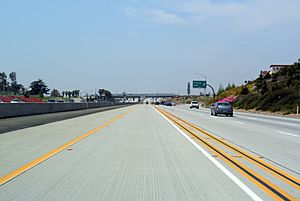
The Metrolink rail service to the greater Los Angeles area has a station that runs through the center of town, connecting to downtown Los Angeles and San Bernardino. The city of Fontana is ten minutes away from Ontario International Airport.
The city is served by Omnitrans bus service. and VVTA. Private transportation operators that serve the city of Fontana include FuturaNet, El Corre Caminos, TUFESA, Los Limosines, and Santiago Express which serve the predominately the Hispanic community seeking transportation to Tijuana, Gomez Palacio, Las Vegas and El Paso.
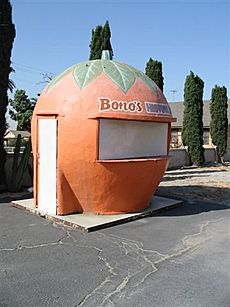
 San Bernardino Freeway
San Bernardino Freeway Ontario Freeway
Ontario Freeway (
( ) Foothill Boulevard (Historic U.S. Route 66)
) Foothill Boulevard (Historic U.S. Route 66) Valley Boulevard (Historic U.S. Route 99)
Valley Boulevard (Historic U.S. Route 99) Foothill Freeway
Foothill Freeway
Utilities
Fontana receives electrical power through Southern California Edison. Gas service is provided by the Southern California Gas Company. Telephone and DSL Internet service are through AT&T and Frontier Communications, though Frontier serves a smaller portion of the city. Charter Communications also provides cable television and cable Internet access. Burrtec Waste provides rubbish and trash collection throughout the city. Burrtec offers both regular waste and green waste recycling programs. Fontana is served by five different water companies, but none of their service areas overlap. These companies are: Fontana Water; the Cucamonga Valley Water District; Marygold Mutual Water; and West Valley Water District, and the city of Rialto. Sewage service in the city is provided by the Inland Empire Utilities Agency, but is billed out by the city of Fontana itself. The Fontana community is serviced by KFON-TV (commonly known as Fontana Community Television), a Government-access television (GATV) station.
Healthcare
Fontana is home to the Kaiser Permanente-Fontana Hospital. Located on Sierra Avenue, and occupying most of the block between Sierra, Marygold, and Palmetto Avenues, and Valley Boulevard, The campus is one of the largest healthcare facilities in the Inland Empire Region. The various facilities are also among the tallest and largest buildings in the city (other than industrial distribution centers). The hospital is home to sixty different specialized departments, plus emergency care.
Located in the north end of the city, along the "Miracle Mile" of Sierra Lakes Parkway and the 210 freeway, is the Sierra San Antonio Medical Plaza, a 60,000-square-foot (5,600 m2) outpatient center and medical office building supported by San Antonio Community Hospital. Services currently available from SSAMP are urgent care, diagnostic radiology, physician offices, and a pharmacy. The facility also includes a 3,000-square-foot (280 m2) educational suite where community lectures, health screenings, awareness campaigns, maternity and CPR classes are held.
Law enforcement
The Fontana Police Department employs 207 sworn officers, as well as civilian personnel. The department was established in October 1952.
In August 2018, Fontana police coerced a false confession from a man named Thomas Perez Jr. for the murder of his father, after Perez had reported his father missing. Fontana police officers interrogated Perez for 17 hours, falsely claiming that his father had been found dead with stab marks and "wore a toe tag at the morgue," and that they would have Perez's pet dog euthanized as a result of his actions. ..... Perez's missing father was confirmed to be alive the same day. In May 2024, Fontana agreed to settle a lawsuit by Perez against the city for $898,000.
Notable people
- Dion Acoff, soccer player
- Hit-Boy, music producer, recording artist
- Travis Barker, musician
- Tyler Chatwood, pitcher for Colorado Rockies of Major League Baseball
- Jesse Chavez, MLB player for the Los Angeles Angels
- Chukwudi Chijindu, soccer player
- Greg Colbrunn, former MLB player, World Series champion
- Jermaine Curtis, MLB player
- Mike Davis, author and commentator
- Joseph Dippolito, Italian American mafia member
- Adam Driver, actor
- Maurice Edu, former soccer player and present color commentator for Atlanta United TV broadcast
- Bill Fagerbakke, television and voice actor, SpongeBob SquarePants
- Sammy Hagar, rock musician (guitarist and vocalist), former member of Montrose and Van Halen
- Alan Harper, pro football player
- Marvin Jones, NFL wide receiver, Cincinnati Bengals
- Sharon Jordan, film and television actress, The Suite Life of Zack & Cody
- Scott Karl, MLB player for Milwaukee Brewers, Colorado Rockies, and Anaheim Angels
- Sam Khalifa, former MLB player
- Bobby Kielty, former MLB player for Oakland Athletics and Boston Red Sox
- Jeff Liefer, former MLB player for Chicago White Sox
- Whitman Mayo, actor (Sanford and Son), lived in Fontana and was once Grand Marshal of the Fontana Days Parade
- Troy Percival, former relief pitcher for 2002 World Series champion Anaheim Angels and Tampa Bay Rays
- Michael Pitre, running back coach for the Atlanta Falcons
- Melissa Ricks, Filipino-American actress, dancer, model and TV host, Star Circle Quest contestant and alumna
- Leo Romero, professional skateboarder
- Sean Rooks, NBA basketball player (retired)
- Alexis Serna, placekicker for Winnipeg Blue Bombers (CFL)
- Jimmy Smith, cornerback for Baltimore Ravens
- Chris Stewart, MLB catcher for Pittsburgh Pirates and New York Yankees
- Eric Weddle, NFL defensive back
- Jamaal Williams, NFL running back for New Orleans Saints
- Marc Wilmore (1963–2021), American television writer, producer, actor, and comedian
- Charlyne Yi, actress and comedian
- Mia Yim, pro wrestler
- Rosearik Rikki Simons, voice actor
See also
 In Spanish: Fontana (California) para niños
In Spanish: Fontana (California) para niños







